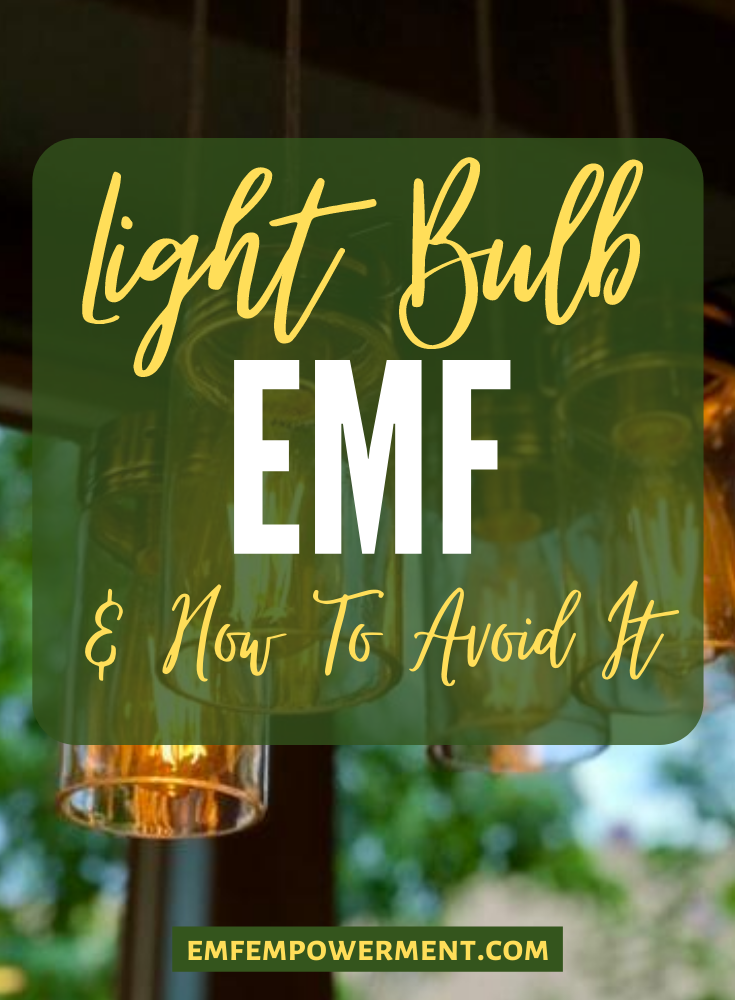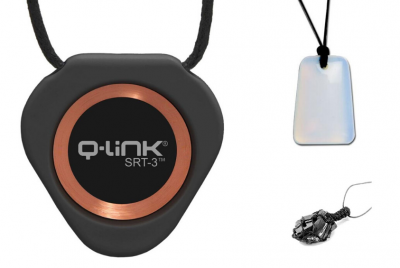When worn correctly, both Bluetooth and wired earbuds offer a lightweight and comfortable way to listen…
Light Bulb EMF Radiation: Everything You Need to Know

*We may earn a commission for purchases made using our links. Please see our disclosure to learn more.
Consider, for a moment, how many light fixtures you have in your bedroom. What about in your entire home? Each room probably has at least one, if not more. And each of those light fixtures probably has a light bulb in it. There’s something to be said for a brightly lit room, after all.
But what if those light bulbs were negatively affecting your health?
It turns out, they may be. Light bulbs have been shown to emit electric and magnetic field (EMF) radiation. And EMF radiation has been tied to a number of health issues. As we’ll talk about later in this article, EMFs have been linked to childhood leukemia, gliomas, and other cancers, reproductive problems, and a slew of other problems.
Tempted to throw out your light fixtures and outfit your home with hundreds of candles? That’s an understandable urge, and you’re not alone.
Fortunately, we’re here to help. We’ll show you how to track down which light fixtures in your home are producing the most EMF radiation, and provide some insight on the safest bulbs to replace them with.
EMF Radiation and light bulbs
Light bulbs produce EMF in a number of ways. Some new smart bulbs have WiFi capability, and the more WiFi-enabled devices in your home, the higher the EMF levels. WiFi radiation has been linked to sperm damage, hormonal and cellular changes, and alterations in brain waves as shown by an EEG. If your home uses WiFi, consider switching to a wired set up and ditching the smart bulbs. At the very least, invest in a good WiFi router guard.
Other smart bulbs use Bluetooth. Bluetooth radiation hasn’t been studied specifically, but Bluetooth produces a type of radiation known as radiofrequency (RF) EMF radiation. RF-EMF radiation has been tied to gliomas and acoustic neuromas, and is designated by the International Association for Cancer Research has potentially carcinogenic. The long-term effects of exposure are virtually unknown.
Another way that light bulbs lead to increased EMF levels is by the production of dirty electricity. Newer bulbs, particularly those that are LED or CFL, use less electricity than the standard 40 or 50 Hz a home is wired for. This leads to an increase in energy efficiency, which is why these bulbs are so popular. However, while the bulb uses less electricity, the same amount of electricity is pulsing through the wires of your home. The light bulb can’t make use of all the electricity flowing to it, so some of this unused electricity is sent back into your home’s wiring. This process creates what is called dirty electricity. Dirty electricity is dangerous because it emits a high level of Extra Low Frequency (ELF) EMF radiation.
Studies have linked ELF-EMF radiation to childhood leukemia. Children whose birth address is in close proximity to high voltage power lines, a large scale producer of ELF-EMF, have a statistically significant increase in their risk of developing childhood leukemia.
You can’t control your proximity to power lines, but you can control the amount of dirty electricity coursing through your home, thus lowering your family’s overall exposure. One way to measure dirty electricity is to use an EMF meter. To see if you have an abundance of dirty electricity, take a reading with all the lights on and then again with all the lights off. If the results are significantly higher with the lights on, you’ve got dirty electricity in your home.
Replacing your lights
You may be wondering what lights in your home need replacing. The best way to track down the biggest offenders of EMF output is to purchase an EMF meter. These devices measure the amount of electric and magnetic fields in the atmosphere. Some detect only ELF-EMF, while others detect RF-EMF. A few detect both, and we would recommend investing in one of those options, if possible.
The TriField TF2 can detect electric, magnetic, and RF frequencies. It produces reliably accurate readings and is the meter we most often recommend. The TF2 is capable of detecting frequencies ranging from 40 Hz to 100 Hz in electric or magnetic mode, and 20 MHz to 6 GHz in RF mode.
For our purposes, we’ll assume you are using a TF2 or another model similarly capable of detecting ELF and RF-EMF radiation, as light bulbs tend to generate both. If you have an EMF meter capable of reading only one form of EMF radiation, that’s fine — take the readings you can, and use common sense to guide you the rest of the way. For example, if you have a smart bulb, you don’t necessarily need to measure the RF-EMF to know it’s being produced.
Meter in hand, go through each room of your house taking readings. Take a reading next to each light fixture, and record your results in a notebook or on a spreadsheet. When you are finished, go through your list and see what fixtures are producing the most EMF. If you don’t plan to replace all the light bulbs at once, prioritize them based on their EMF output and location in the home. A high producing bulb in the bathroom is probably not as urgent as one in the living room, because people tend to spend more time in the living room. Removing bulbs from high-traffic areas should be the first priority.
It’s important, as well, to repeat this step after you replace your lights. That way you can help determine if the light fixture itself is producing an unacceptable amount of EMF radiation.
So now you know how to track down dangerous bulbs. That begs the question — what bulbs should you replace them with? Are there any you should steer clear from?
Keep reading to find out.
Low EMF light bulbs
The safest light bulbs to use from an EMF standpoint are incandescent light bulbs. These bulbs were designed to work with the wiring in most homes, meaning they produce little to no dirty electricity. And because of their simpler design, you’re looking at no RF-EMF production. The amount of ELF-EMF produced varies but can be kept to a minimum by choosing the lowest wattage bulbs possible.
While they may not be as energy-efficient or long-lasting as other bulbs, incandescent bulbs do tend to be cheaper. You can grab a 24-pack for around $20 give or take, depending the brand you choose and the wattage. One or two packs of those and you’ll be set for a while.
Light bulbs to avoid
If possible, avoid smart bulbs that use WiFi or Bluetooth. These bulbs may be convenient, but the risks aren’t worth the rewards. Smart bulbs are usually LED-based, which means they produce dirty electricity. And as we already know, dirty electricity produces ELF-EMF radiation. Not only do these bulbs produce ELF-EMF radiation, but their WiFi or Bluetooth signals produce dangerous RF-radiation, as well.
Other bulbs to avoid include regular LED and CFLs. The dirty electricity alone is reason enough — our homes simply aren’t wired to accommodate these low wattage bulbs. These bulbs can produce radio frequencies of their own, too, so you aren’t free from the effects of RF-EMF radiation with these bulbs, either.
Another type of bulb to avoid is the remote-controlled type. Sometimes sold as light strips, or just a single bulb, they are typically LED-based. The remote control produces some degree of radiation, as well.
Minimizing exposure
Minimizing your exposure is key to avoiding the health problems associated with EMF radiation. Your best bet is to use incandescent bulbs. They produce minimal EMFs, they are inexpensive, and easy to replace. One word of advice, however, is to stock up on them now. There is no guarantee they will make incandescent bulbs forever, and as they are older technology it’s possible they could be phased out in the future.
If you must use LED bulbs, smart bulbs, or CFLs, use them as sparingly as possible. Try and place those lights away from nightstands, chairs, and other places where they might come into close contact with people. Turn the lights off when they aren’t in use, and try to limit the number of them in the home. If you have smart lighting in the bedroom and living room, for example, make sure there are still lamps in those rooms with incandescent bulbs, as well. When you’re in the room for an extended period of time, turn off the smart lights and turn on the incandescents.
Light bulbs at work
It’s worth noting that this article is geared mainly towards identifying and replacing hazardous light bulbs in the home. There is another place where we spend a great deal of our time — the office — and it warrants some consideration here, too. Offices have notoriously terrible and unflattering lighting, not to mention the EMF radiation. Is there anything you can do?
In most instances, the overhead lighting in an office is outside of our control. Many companies opt for LED or fluorescent overhead lights because they are cheap and long-lasting. If you work in an office with an open floor plan, there may be nothing you can do to shield yourself at work. Some swear by the stone shungite, carrying it around with them to help ward off EMF radiation. Shungite’s EMF-repelling properties haven’t been studied, however, so its reputation is anecdotal at best. At a minimum, try and step outside a few times throughout the day to give your body a break from the lighting.
If you have your own office, there are some other things you can do to lower your EMF exposure during the day. Bring in some light fixtures of your own with incandescent bulbs, and shut off some or all of the overhead lights. You may need company approval prior to doing this, however, as some places frown upon personal electronics. You could also open the windows, if that’s an option, and use natural light during the brighter parts of the day. Not only would that minimize your EMF exposure, but the natural sunlight provides a mental boost.
If you aren’t at an office — if you work in retail, for example — you may not be able to do much about the lighting in the store. If that’s the case, simply focusing on reducing your levels at home is still a great way to reduce your overall exposure.
Closing Thoughts
EMF radiation has become a growing concern in recent years. Government regulations are not sufficient to protect us from its harmful effects, making it necessary for the average individual to take steps to protect themselves. Because light bulbs are so widely used throughout the home, finding lower-EMF bulbs is one way to dramatically decrease your home’s overall EMF levels.
In addition to lowering your home’s EMF levels, it’s also a good idea to think about your exposure during the workday. There may be nothing you can do, but you may also be able to bring in your own light fixtures or influence an office-wide shifting to safer bulbs or natural lighting.
Switching to the older-style, incandescent bulbs is the generally preferred solution, as they produce very little EMF radiation. Incandescent bulbs are inexpensive and available in a variety of wattages — for the lowest EMF option, try and find the lowest wattage of bulb that meets your lighting needs.
Natural light, however, is the safest bet. When it’s an option, consider turning the lights off and opening the curtains to let some sunlight in. This is a great way to reduce your home’s EMF levels during the day when other EMF-producing devices are likely in use.
Other lifestyle changes, such as turning lights off when they aren’t in use, are also a good idea to minimize your risks from EMF radiation exposure. Not only will you be protecting your family, but you’ll be saving on your electric bill, as well.
There’s a lot you can do to protect you and your family from the EMF radiation produced by lightbulbs. Common sense steps and a little bit of effort will go a long way. 



